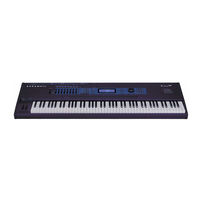Kurzweil K2600 AES Manuals
Manuals and User Guides for Kurzweil K2600 AES. We have 2 Kurzweil K2600 AES manuals available for free PDF download: Musician's Manual, Introduction Manual
Kurzweil K2600 AES Musician's Manual (598 pages)
Kurzweil K2600: User Guide
Brand: Kurzweil
|
Category: Electronic Keyboard
|
Size: 7 MB
Table of Contents
-
-
Welcome23
-
-
-
-
All Models31
-
-
-
Programs36
-
Setups38
-
Quick Access39
-
-
-
-
Mode Buttons42
-
-
Navigation43
-
The Display43
-
Pages43
-
The Top Line43
-
The MIDI LED44
-
-
Data Entry45
-
Search48
-
-
-
-
Program Mode55
-
Setup Mode56
-
Effects Mode56
-
MIDI Mode56
-
Master Mode56
-
Song Mode57
-
Disk Mode57
-
-
-
Background67
-
KB3 Mode70
-
-
Opaque88
-
-
Fine Hz93
-
-
-
Adjust94
-
Key Tracking94
-
Pad95
-
-
-
-
Monophonic99
-
Legato Play99
-
Portamento99
-
Portamento Rate100
-
Globals100
-
Outpair101
-
-
-
Decay Segment103
-
Release Segments103
-
Loop Type103
-
Number of Loops104
-
-
Adjust106
-
Key Tracking106
-
Source, Depth106
-
Impact106
-
-
The LFO Page106
-
Minimum Rate107
-
Maximum Rate107
-
Rate Control107
-
LFO Shape107
-
LFO Phase108
-
-
The ASR Page108
-
The KDFX Page110
-
-
The TONEWL Page114
-
Upper/Lower Swap116
-
Wheel Volume Map116
-
Organ Map116
-
Lowest Pitch116
-
The DRAWBR Page117
-
The PITCH Page118
-
The PERC Page118
-
The PERC2 Page120
-
The KEYCLK Page120
-
Keyclick121
-
Volume121
-
Decay121
-
Pitch121
-
Veltrk121
-
Random121
-
Retrigthresh121
-
Note Release122
-
-
The AMP Page122
-
The OUTPUT Page122
-
The MISC Page123
-
Preampresp123
-
Leakage123
-
Leakmode123
-
Speedctl124
-
Vibchorctl124
-
Vibchorsel124
-
Voladjust124
-
Bendrange124
-
Sustain124
-
Sostenuto124
-
-
The EQ Page125
-
Programming Tips125
-
-
-
Setup Mode129
-
The Setup Editor134
-
-
Channel135
-
MIDI Bank136
-
Status137
-
MIDI Bank Mode139
-
The BEND Page148
-
Controllers149
-
-
Scale154
-
Offset (Add)154
-
Curve (Curv)155
-
The RIBBON Page157
-
The WHEEL Page159
-
-
Destination160
-
On Value161
-
Off Value161
-
The SWITCH Page162
-
The COMMON Page163
-
-
Active166
-
Sync166
-
Latch167
-
Order168
-
Beats168
-
Tempo168
-
Note Shift168
-
Shift Limit168
-
Limit Option169
-
Glissando170
-
Velocity170
-
Duration170
-
Spring173
-
Center173
-
-
-
Name173
-
Save173
-
Delete173
-
Dump174
-
New Zone (Newzn)174
-
Copy and Paste174
-
Clear175
-
-
-
-
Introduction179
-
Terminology180
-
Studio180
-
FX Preset181
-
Algorithm181
-
Size/Paus181
-
Parameters181
-
FX Mode182
-
Studio Editor182
-
-
-
-
The Studio185
-
-
-
-
-
Control Setup208
-
Channel208
-
Transpose208
-
Control208
-
-
The RECEIVE Page211
-
Basic Channel211
-
All Notes off212
-
Scsi ID212
-
Bend Smooth213
-
Bank Select215
-
Power Mode215
-
-
-
-
Panic224
-
-
-
-
Tune225
-
Transpose226
-
KB3 Channel226
-
Intonation226
-
Conþrm228
-
-
The MAST2 Page228
-
The Vocoder228
-
-
Object Utilities237
-
-
-
RAM Tracks259
-
Using Song Mode261
-
-
Tempo267
-
Program268
-
Channel (Chan)269
-
Setup269
-
Pan270
-
Mode270
-
Location (Locat)270
-
Track Channels271
-
The Song Editor283
-
-
Tempo284
-
Timesig284
-
Effectchan284
-
Chainto284
-
-
-
-
Disk Mode Page312
-
SCSI Termination313
-
Directories315
-
File List Dialog317
-
Saving Files334
-
The Name Table341
-
Macros353
-
The Macro Page353
-
Macro Modes354
-
The Macro Table355
-
Macro Entries360
-
The Library Disk362
-
Editing Macros364
-
Macro Insert367
-
-
Disk Utilities370
-
Find Files371
-
List372
-
Free373
-
Renaming Files375
-
-
-
File Backup377
-
File Copy379
-
-
-
Eps385
-
-
-
-
Editing Samples396
-
Live Mode427
-
-
Personalities433
-
Navigating KDFX433
-
Fxbus434
-
Parameters435
-
-
-
Input Section438
-
The Arrow Meter439
-
Fxbus Sends439
-
FX Preset441
-
-
Effects Buses441
-
The Arrow Meter441
-
Bus Outputs441
-
The Aux Bus442
-
About FX Presets443
-
-
Output Section450
-
-
Disk Functions453
-
-
-
-
Reverbs468
-
Delays469
-
Complex Echo470
-
Equalizers (EQ)470
-
Chorus473
-
Laserverb474
-
Filters475
-
Distortion476
-
Ring Modulation479
-
Fxmod Diagnostic481
-
Special Topics482
-
Song Mode482
-
KB3 Effects483
-
-
-
-
-
Filters490
-
Mixers521
-
Waveforms522
-
Added Waveforms525
-
-
Chapter 17 FUNS
541 -
-
Run System583
-
Hard Reset583
-
Run Diags583
-
Index
585
Advertisement
Kurzweil K2600 AES Introduction Manual (9 pages)
Kurzweil K2600: User Guide
Brand: Kurzweil
|
Category: Electronic Keyboard
|
Size: 0 MB
Table of Contents
Advertisement
Related Products
- Kurzweil K2600S
- Kurzweil K2600X
- Kurzweil K2600 BEST OF VAST - REV A
- Kurzweil K2600 - MUSICIANS GUIDE REV A PART NUMBER 910330 CHAP 1
- Kurzweil K2600 - MUSICIANS GUIDE REV A PART NUMBER 910330 CHAP 3
- Kurzweil K2600 - MUSICIANS GUIDE REV A PART NUMBER 910331 CHAP 1
- KURZWEIL K2600 - MUSICIANS GUIDE REV A PART NUMBER 910330 CHAP 13
- KURZWEIL K2600 - MUSICIANS GUIDE REV A PART NUMBER 910330 CHAP 17
- KURZWEIL K2600 ROM - INSTALLATION REV E
- KURZWEIL K2600 V2.0 - MUSICIANS GUIDE SUPPLEMENT REV A

